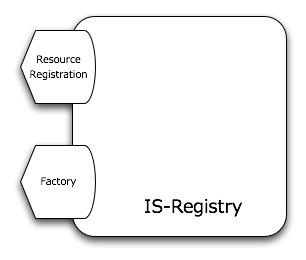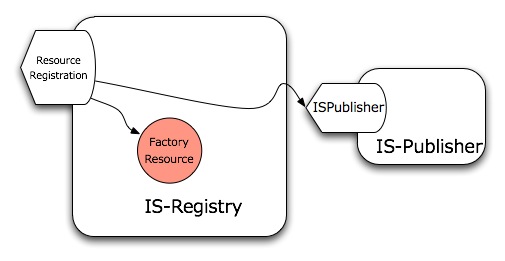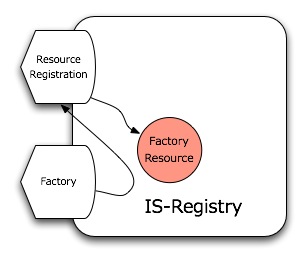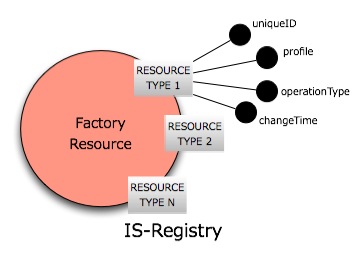Difference between revisions of "IS-Registry"
Manuele.simi (Talk | contribs) (→Factory) |
Manuele.simi (Talk | contribs) (→Factory) |
||
| Line 41: | Line 41: | ||
[[Image:IS-Registry Resource.jpg|frame|center|Figure 3. IS-Registry FactoryResource]] | [[Image:IS-Registry Resource.jpg|frame|center|Figure 3. IS-Registry FactoryResource]] | ||
| + | |||
| + | This is the list of RPs exposed: | ||
| + | <source lang="xml"> | ||
| + | <xsd:element name="RegistryFactoryResourceProperties"> | ||
| + | <xsd:complexType> | ||
| + | <xsd:sequence> | ||
| + | <xsd:element ref="tns:RunningInstance" minOccurs="1" maxOccurs="1"/> | ||
| + | <xsd:element ref="tns:ExternalRunningInstance" minOccurs="1" maxOccurs="1"/> | ||
| + | <xsd:element ref="tns:Service" minOccurs="1" maxOccurs="1"/> | ||
| + | <xsd:element ref="tns:Collection" minOccurs="1" maxOccurs="1"/> | ||
| + | <xsd:element ref="tns:GHN" minOccurs="1" maxOccurs="1"/> | ||
| + | <xsd:element ref="tns:MetadataCollection" minOccurs="1" maxOccurs="1"/> | ||
| + | <xsd:element ref="tns:GenericResource" minOccurs="1" maxOccurs="1"/> | ||
| + | </xsd:sequence> | ||
| + | </xsd:complexType> | ||
| + | </xsd:element> | ||
| + | </source> | ||
| + | |||
| + | where the each resource type is defined as <code>ResourceProperty</code>: | ||
| + | |||
| + | <source lang="xml"> | ||
| + | <xsd:complexType name="RegistryProperty"> | ||
| + | <xsd:sequence> | ||
| + | <xsd:element name="uniqueID" type="xsd:string" nillable="true"/> | ||
| + | <xsd:element name="profile" type="xsd:string" nillable="true"/> | ||
| + | <xsd:element name="operationType" type="xsd:string" nillable="true"/> | ||
| + | <xsd:element name="changeTime" type="xsd:dateTime" nillable="true"/> | ||
| + | </xsd:sequence> | ||
| + | </xsd:complexType> | ||
| + | </source> | ||
== Sample Usage == | == Sample Usage == | ||
Revision as of 22:43, 8 April 2011
Role
The IS-Registry is the gateway to entering in a gCube infrastructure for gCube resources by means of registering/unregistering their profiles.
The IS-Registry performs three fundamental tasks:
- decide if accept or not a new resource
- validate a resource before its registration
- execute post-deletion actions to keep consistent the IS content
Design
The design of the service is distributed across two port-types: the ResourceRegistration and the Factory.
ResourceRegistration
The ResourceRegistration port-type manages the registration/update/removal of GCUBE Resources. It is directly contacted only by the IS-Publisher in order to perform such operations.
It exposes three operations:
- ...
- ...
- ...
Factory
From the functional point of view, the Factory port-type is practically a wrapper around the ResourceRegistration port-type to provide backwards compatibility to previous IS-Publisher and testers implementation. Therefore, it exposes the following operations:
-
createResource– which takes as input parameter a message containing a resource profile and a set of registration directives (e.g. VO membership and VRE membership) and returns a string containing the whole profile of the new resource including the automatically assigned ID; -
updateResource– which takes as input parameter a message containing the new profile that is supposed to replace an existing one. The key to identify the old profile to be replaced is contained in the profile itself, it is the resource ID. By relying on the internal mapping between IDs and EPRs it identifies the WS-Resource it has to interact with in order to implement such update operation; -
removeResource– which takes as input parameters a message containing the resource ID identifying the resource to be removed and its type;
The Factory is also in charge of creating the singleton FactoryResource. This resource exposes a set of WS-ResourceProperties registered as Topics in the IS-Notifier, making possible for interested clients to subscribe on events representing the changes of status of Infrastructure constituents (e.g. the disappearance of a Running Instance).
This is the list of RPs exposed:
<xsd:element name="RegistryFactoryResourceProperties"> <xsd:complexType> <xsd:sequence> <xsd:element ref="tns:RunningInstance" minOccurs="1" maxOccurs="1"/> <xsd:element ref="tns:ExternalRunningInstance" minOccurs="1" maxOccurs="1"/> <xsd:element ref="tns:Service" minOccurs="1" maxOccurs="1"/> <xsd:element ref="tns:Collection" minOccurs="1" maxOccurs="1"/> <xsd:element ref="tns:GHN" minOccurs="1" maxOccurs="1"/> <xsd:element ref="tns:MetadataCollection" minOccurs="1" maxOccurs="1"/> <xsd:element ref="tns:GenericResource" minOccurs="1" maxOccurs="1"/> </xsd:sequence> </xsd:complexType> </xsd:element>
where the each resource type is defined as ResourceProperty:
<xsd:complexType name="RegistryProperty"> <xsd:sequence> <xsd:element name="uniqueID" type="xsd:string" nillable="true"/> <xsd:element name="profile" type="xsd:string" nillable="true"/> <xsd:element name="operationType" type="xsd:string" nillable="true"/> <xsd:element name="changeTime" type="xsd:dateTime" nillable="true"/> </xsd:sequence> </xsd:complexType>
Sample Usage
[TBP]



